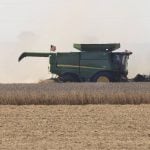A new Canadian pea crop estimate helped bolster prices last week and
analysts expect a continued rise.
Benson-Quinn-GMS Inc. has pegged this year’s crop at 1.15 million
tonnes, which is 400,000 tonnes smaller than Statistics Canada’s July
pea forecast.
The revised number, combined with news of small crops in France and
India, caused a surge in pea prices. Growers were getting between $7.50
and $8.50 per bushel on the farm for top grade green peas and $6.50 for
No. 1 yellows.
Read Also

Why feds imposed EV tariffs
Moe and Kinew have a fight on their hands when it comes to eliminating the EV tariff. Canada has to worry about pissing off the U.S. and Mexico and hundreds of thousands of auto workers.
Reports out of France peg that crop at 1.69 million tonnes, down
slightly from last year’s 1.77 million tonne crop. India’s ministry of
agriculture is forecasting a 17 percent decline in pulse production
during its latest growing season due to a lack of monsoon rains in July.
Murray Challice, a broker with Johnston’s Grain Marketing, said the run
on prices will probably continue, considering some bids in Western
Canada have been higher than what export markets are paying.
“There has been some speculation going on – some people moving up and
trying to take control of the peas before there is a shortage and we do
believe there is a shortage of yellows especially, and good quality
greens also.”
Challice said Canadian yields are all over the map, ranging from eight
bushels per acre to crops in excess of 50 bu. per acre. Farmers who got
30 bu. per acre of yellow peas are already at a point where revenues
are approaching that highly sought after $200 per acre return.
“If I had some in the bin, I’d be pricing some now. I don’t think I’d
price them all,” said the broker.
“I do think there’s room for those pea prices to move upwards.”
Part of the reason for his optimism is that France has already shipped
most of its peas to the Indian subcontinent and buyers are starting to
look elsewhere for supplies.
“The peas are drying up in Europe somewhat and that has brought the
next phase to Canada …. That’s what I think seems to be heating the
market up here at this point.”
The Benson-Quinn forecast has also had an impact, but Challice is a
little skeptical about that number. He thinks it is too early to have a
good read on the crop because farmers are still harvesting.
But David Reimann, manager of floor trading with Benson-Quinn, said its
1.15 million tonne estimate might even be optimistic.
The company arrived at its number by applying its yield estimate to
Statistics Canada’s July acreage estimates and abandonment rates of two
percent for Manitoba, 14 percent for Saskatchewan and 30 percent for
Alberta. But Reimann said those abandonment rates could easily be
higher.
Larry Weber, a trader with Weber Commodities Ltd., said if the
Benson-Quinn number proves true, the federal statistician is going to
look silly.
“It looks like for the second year in a row StatsCan will have screwed
the farmer with BS estimates of production. Last year they were out on
their estimate by 16 percent and if this number is close, they will
have blown this year’s by 26 percent,” said Weber in his newsletter.
But Reimann said it’s hard to question the federal agency’s numbers
because they surveyed 16,700 farmers compared to the “couple hundred”
interviewed by Benson-Quinn.
“There’s times when I’ve looked at their numbers too and wondered about
things, but at the same time it’s difficult to take on a survey of that
size and say, ‘Well, they must be wrong.’ “
He doesn’t believe there is anything nefarious going on.
“I don’t think that StatsCan intentionally tries to go out and lead the
market or influence price in that sense by distorting the numbers. I
really don’t think that they would do that.”
The federal statistician’s next report comes out Oct. 4.















